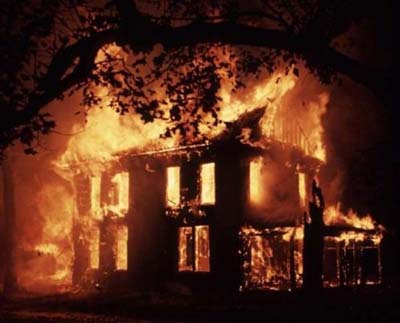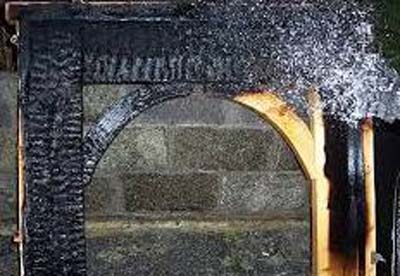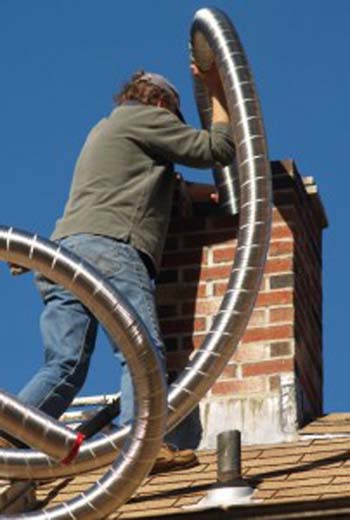IMPROPER CHIMNEY & FIREBOX INSTALLATION
Improper Chimney and Firebox Installation
- Improper Chimney Installation - what occurs and what problems result
-

- Today, building codes specifically include chimneys and code enforcement agencies will inspect newly constructed chimneys prior to use. As a result, most chimney fires
like the one that caught this house
on fire below, occur from older homes that were built before building codes and safety inspections for chimneys were mandatory. If your home is from the 1980’s or older, it runs a higher risk of catching on fire from an improper chimney installation before safety codes were enforced.
- If you have recently purchased an older home, an inspection by a trained chimney professional is needed to ensure that your fireplace was installed properly and follows the National Fire Protection Association’s guidelines. Unfortunately, too many chimneys fail due to improper construction or improper installation. Here are just a few of the errors that could exist in your chimney if the installation does not meet proper guidelines: improper clearance to combustibles (there should be approximately one inch between brick and any wood framing), improper venting due to poor connections, improper venting due to incorrect chimney height, or incorrect insulation installations. One example, after many hours of continuous use, bricks in a chimney heat up to such a high temperature that wood framing directly nailed to a part of the chimney brick gets to hot and catches on fire! Another example, improper installation can occur if the chimney chase is left open in the attic and the insulators blow in cellulose insulation. The insulation then travels down the chimney chase and traps the heat around the fireplace insert. The trapped heat near the insert causes wood and any other combustible material to start a fire.
- Improper Chimney Flashing Install
-

- Here is a diagram of correct flashing installation. An improper chimney flashing install is usually done because the person usually skips a vital step or cuts corners completely. If you notice water on your ceiling, it is likely an improper flashing install. The flashing could also be missing, rusted through or cracking after years of use. Chimney flashings need counter flashing and step flashing to remain airtight. Keep in mind that the chimney is not attached to the house frame and it can pull away from the roof unless the counter flashing and step flashing are properly nailed into place. The step flashing also needs to be turned out in a manner that directs water away from the chimney wall and onto the roof. Any chimney that has roofing mastic or silicone caulk surrounding the chimney rather than proper flashing is also in need of immediate repair.
- Problems that can occur during Heating Appliance Installation
- The main issue we run into when installing a furnace or water heater is an improperly sized flue. This is typically because the flue was built for an older fireplace and the modern heating appliance is not compatible. Without proper drafting, harmful flue gasses from the appliances are vented into your home. On top of this, modern advances in home energy efficiency have ensured that homes have become tighter and tighter to air exchange. In winter, they keep the warm air in and the cold air out and vice versa in the summer time. This has created a perfect storm for improperly venting gas furnaces and water heaters from improperly sized flues because they can catch on fire without proper drafting and start a house fire. Be sure to follow the safety manual that comes with any heating appliance installation and consult a professional chimney sweep if you are unsure it was installed properly.
- Problems that can occur during Fireplace Installation
- An improper firebox to flue ratio or a fireplace that was manufactured incorrectly will lead to fires. Also, if your firebox is too shallow (less than 20 inches), then smoke may enter the room rather than exiting through the appropriate flue. A fireplace insert is the metal box that is meant to fit up against the brick or stone fascia and hearth. The connection point should also contain refractory cement which prevents heat from getting into the space between the insert and the chase. The same cement material is used for wood burning fireplaces with gas igniters. If the insert is not installed, it can lead to a chimney fire.

This picture demonstrates what happens to a fireplace wooden frame that did not have proper clearance. It was removed from the house and extinguished. NEVER install a fireplace in a bathroom or recreational vehicle, or where curtains, furniture, clothing, or other flammable objects are less than 42 inches from the front, top or sides. Windy or drafty areas are not acceptable for a fireplace installation either. Have a professional chimney sweep evaluate the installation, clearances, codes, and regular maintenance for you prior to using your fireplace. This is the best assurance that it is safe and ready for use. - Improper Chimney Liner Installation
-

- Improper liner installations usually occur due to improper size fit for the firebox or heating appliance they are attached to, its placement within the home, or its shape. The ideal flue pipe assembly is one that rises straight up from the appliance flue collar and directly into the chimney with no elbows. Elbows restrict airflow. Liner angles can also cause problems because the heat may not produce enough force to leave through a non-vertical passageway through the chimney walls. You also want to ensure that your chimney liner does not pass through a combustible floor or ceiling or through an attic, roof space, closet or concealed space. There is no easy answer for ensuring the size of your liner is adequate to the heating appliance without getting into the specifics of your house, heating unit, chimney, and liner. Therefore, it is highly recommended you call a professional sweep to review the specifics of your building to make sure it is up to code.
- Chimney Installation Code and Safety Guidelines
- The National Fire Protection Agency (NFPA) code 211 covers the "proper installation of solid fuel-burning appliances, and the correct construction and installation of chimneys, fireplaces, and venting systems." It details the clearances needed when installing your heating system beyond what will be provided by the safety manual from your purchase. It also mandates "initial installation of chimneys, fireplaces, and vents shall allow inspection of the surroundings to determine that the required clearances have been maintained and that correct provisions for support, stabilization, future inspection, and maintenance are in place." Your professional chimney sweep will ensure that you are following the NFPA's safety code so you can enjoy your heating system to the fullest.
